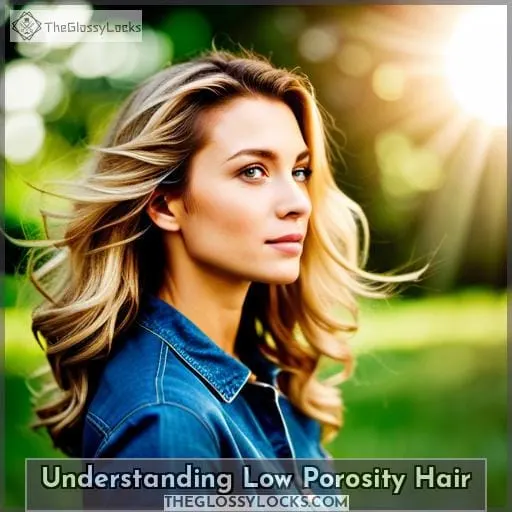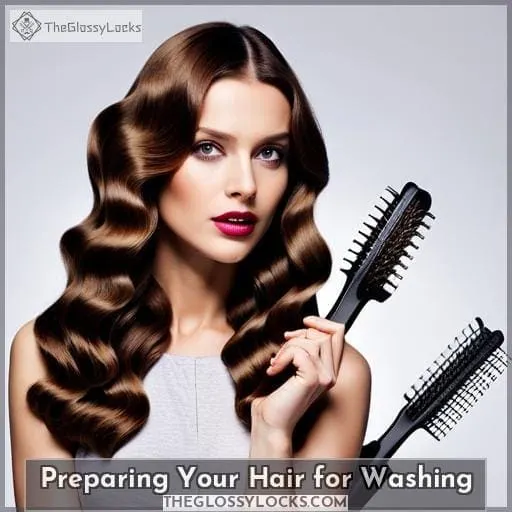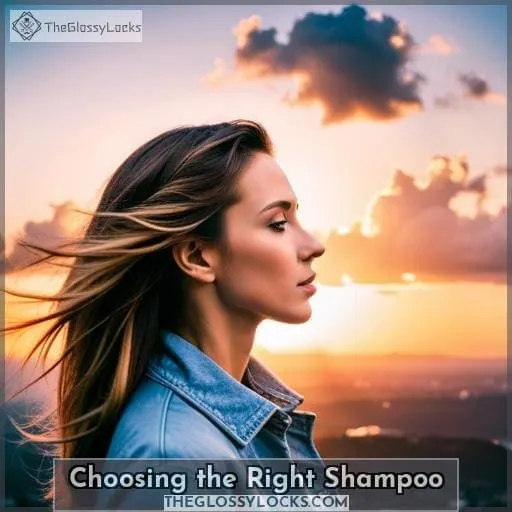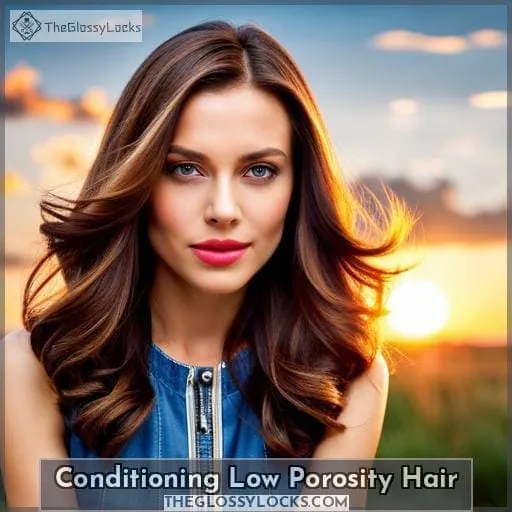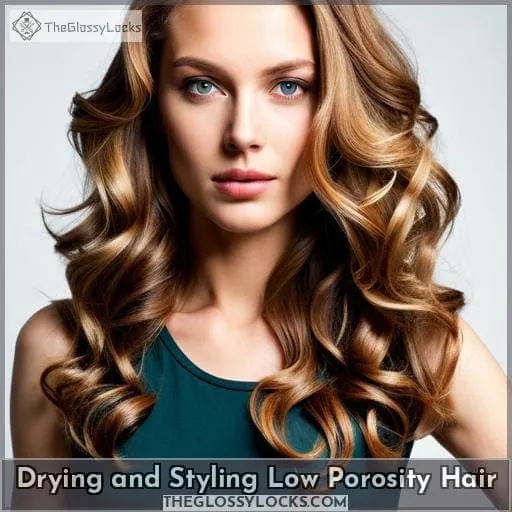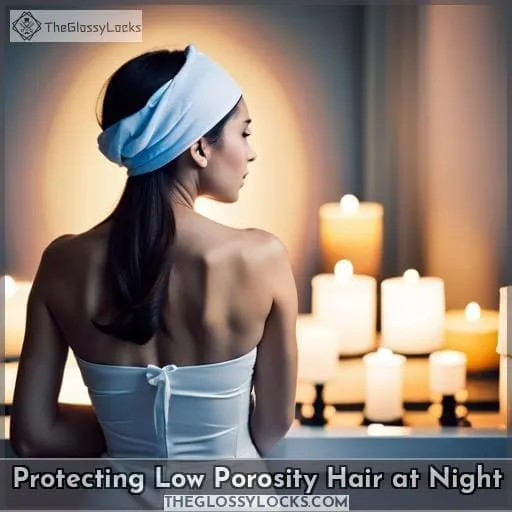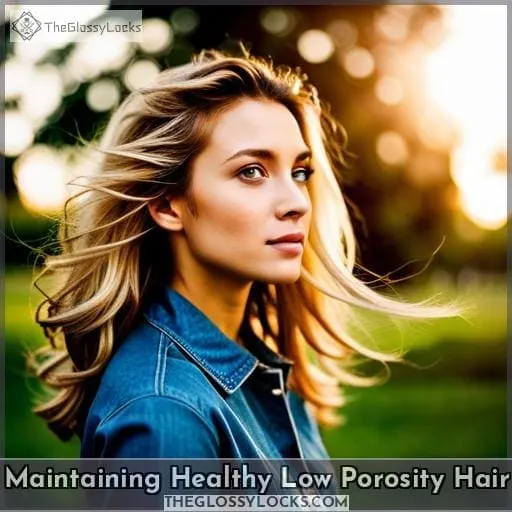This site is supported by our readers. We may earn a commission, at no cost to you, if you purchase through links.
Are you tired of your low porosity hair not absorbing moisture? Do you feel like no matter how much product or water you apply, it still remains dry and frizzy? You are not alone. Low porosity has its unique challenges when it comes to taking care of your hair.
But don’t worry! With the right knowledge and techniques, there is hope for those with this type of hair.
Read on for tips on pre-poo treatments, shampoo selection, conditioning methods as well as drying and styling advice – everything you need to know about caring for low-porosity locks!
Table Of Contents
- Key Takeaways
- Understanding Low Porosity Hair
- Why Washing Low Porosity Hair is Different
- Preparing Your Hair for Washing
- Choosing the Right Shampoo
- Conditioning Low Porosity Hair
- Drying and Styling Low Porosity Hair
- Protecting Low Porosity Hair at Night
- Maintaining Healthy Low Porosity Hair
- Frequently Asked Questions (FAQs)
- Conclusion
Key Takeaways
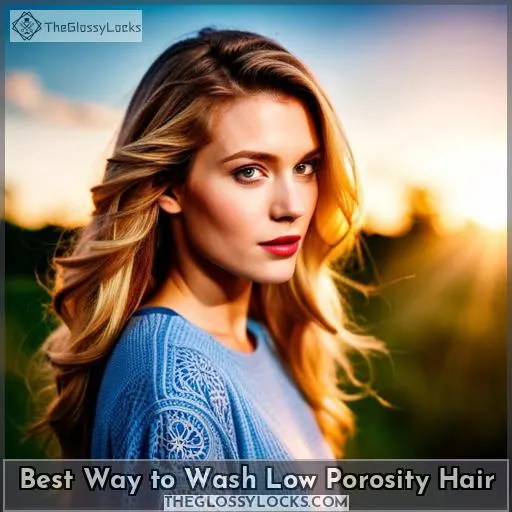
- Warm water washing is essential for low porosity hair to open the cuticles and aid in moisture absorption.
- Clarifying shampoos like Moroccanoil’s will help remove any buildup.
- Lukewarm water and wide-tooth combs should be used for washing and detangling low porosity hair.
- Low porosity hair should be washed once a week with a gentle clarifying shampoo or an apple cider vinegar rinse.
Understanding Low Porosity Hair
You have low porosity hair if it’s difficult to wet, dry, and style. This may be due to its tightly packed cuticles that are flat and smooth. It’s important to understand your hair porosity to properly care for it. Low porosity hair can accumulate products outside the shaft, leading to buildup.
On the other hand, high-porosity locks can easily become damaged by chemical treatments or stress levels.
To determine your hair’s porosity, drop a strand into water or feel its texture when sprayed with water. Signs of low porosity include weighed down tresses with slow drying times, as well as an oily appearance from product sitting on top of the strands.
Protective styling, such as deep conditioning and steam treatments, should form part of your weekly routine. Avoid heavy oils and protein-rich treatments because they could damage your delicate tresses too much.
Clarifying shampoos like Moroccanoil’s will help remove any buildup, while pre-poo treatment will also aid hydration before shampooing itself using warm but not hot water. The maximum hydration method has been effective for afro-textured low porosity types, so don’t forget about this either! Healthy locks depend on following all these tips correctly, so you’ll soon see positive results in no time at all.
Why Washing Low Porosity Hair is Different
Due to its tightly packed, flat cuticles, low porosity hair requires a different approach when it comes to washing. This can make wetting and drying difficult. To determine your porosity level, use the simple hair porosity strand test.
Drop one strand of your hair into room temperature water. If it takes 5 or more seconds for the strand to start sinking, you have low-porosity hair that resists moisture absorption. Adjust your washing routine accordingly. This type of haircare is prone to product buildup if not washed frequently enough with light products such as aloe vera gel or vinegar rinses.
These help open up closed cuticles without overloading protein treatments, which can further damage already fragile strands. Moreover, using shampoo too often strips away much-needed natural oils from the scalp, preventing proper moisturizing techniques.
Preparing Your Hair for Washing
If you have low porosity hair, pre-pooing and washing with warm water are essential steps to ensure that your hair is properly hydrated and clean. Pre-poo treatments help reduce friction caused by shampoo while also adding moisture to the strands of your hair.
Warm water helps to open up the cuticles on the scalp so that dirt, oil, and product buildup can be removed more efficiently when it comes time to wash with a cleanser or shampoo.
Pre-Poo Treatment
Before washing your hair, consider trying a pre-poo treatment to open up the cuticles and help with moisture absorption. Pre-poo treatments are beneficial for those with low porosity hair who want to avoid product buildup and deep conditioning before wash day.
Light oils like coconut oil or argan oil can be used, but protein treatments should be avoided as they can cause protein overload in this type of hair. During pre-poos, heat tools such as curling irons or flat irons should also be avoided as they will damage the cuticles of your hair further.
Hair steaming is an excellent option for adding moisture while avoiding chemical treatments. If you have Afro-textured low porosity strands, you can use a portable steamer at home using the maximum hydration method.
When it comes to moisturizing low porosity locks, lightweight products with humectants work best since heavy products tend to weigh down this type of tresses instead of hydrating them properly.
Warm Water Washing
To properly care for your low porosity hair, warm water washing is essential. This helps to open the cuticles and aid in moisture absorption. The warm water also breaks down any product buildup on the hair shaft and loosens up tight curls.
Deep conditioning treatments are beneficial for low porosity hair as they provide an extra layer of hydration. This can help with moisturizing treatments such as oil or leave-in conditioners. Steam hydration is another great way to infuse moisture into low porosity hair. It allows for deeper penetration than just using regular hot water alone.
Apple cider vinegar rinses are often used by those with this type of texture. They strip away product buildup without disrupting the delicate balance between proteins and lipids in the strands. This could lead to protein overload if too much product was left behind from cleansing sessions over time.
Following these tips will ensure healthy locks regardless of your specific Hair Porosity Type!
Choosing the Right Shampoo
If you have low porosity hair, the best way to wash it is with a residue-free shampoo followed by a clarifying shampoo. Residue-free shampoos are specifically formulated to not leave behind any product buildup on your hair and scalp.
Clarifying shampoos will help remove dirt, oil, and other impurities that can further weigh down your already weighed-down strands of low porosity hair.
Residue-Free Shampoo
For low porosity hair, using a residue-free shampoo is like giving your locks a fresh start. It washes away all the old product buildup and leaves them feeling clean and hydrated.
- Deep conditioning with heat protection is ideal to nourish hair strands.
- Hair steaming helps open cuticles so water molecules can be absorbed more easily.
- Selecting suitable low-porosity hair products will make sure that you don’t block moisture from entering the shafts.
- Moisturizing sprays add an extra layer of hydration after washing.
With this approach, you’ll notice an improved look in texture and shine as well as overall healthier looking locks! Remember to focus on lightweight moisturizing products without silicones for best results when caring for low porosity hair.
Clarifying Shampoo
Using a clarifying shampoo can help remove product buildup and keep your low porosity hair refreshed. Clarifying shampoos contain stronger cleansing properties than regular shampoos, allowing them to penetrate more deeply into the strands of curly or low porosity hair.
They are designed to strip away dirt, oils, and other impurities that may be preventing moisture from reaching the cuticles of your strands.
Additionally, they can help break down any product buildup which could be weighing down your curls or making it difficult for conditioners and moisturizing masks to absorb properly into the shafts of your strands.
When using a clarifying shampoo, it is important to also use lightweight water-based products such as conditioner afterwards in order to restore moisture back into the strand after removing all residue from protein treatments or heat tools previously used on it.
Finally, utilizing steam with portable hair steamers like EZBasics Hair & Facial Steamer once every few weeks will open up closed cuticles easily so hydration can reach deep within each layer for maximum results.
Conditioning Low Porosity Hair
If you have low porosity hair, it can be difficult to keep your locks healthy and strong. One of the best ways to care for this type of hair is by diluting your conditioner with water before applying it and using lightweight, water-based products that won’t weigh down your strands.
This will help ensure that moisture penetrates deep into the shafts for long-lasting hydration and strength.
Diluting Your Conditioner
You can improve the effectiveness of your conditioner by diluting it with water. In fact, research has shown that doing so can increase moisture absorption for low-porosity hair up to four times! Diluting conditioners helps fill the little space between cuticles and allows humectants usage.
It also prevents protein overload, which is a common issue with low porosity hair.
When using diluted leave-in conditioning spray, use light layers on dry ends as they are more prone to product buildup and dryness. Heat styling should be avoided as much as possible or used sparingly because heat damages fragile strands of this type of hair easily.
Deep conditioning treatments, such as Shea Moisture Raw Shea Butter Deep Moisturizing Masque, help nourish and hydrate low porosity locks while avoiding heavy products that may weigh down your mane further.
Using Lightweight, Water-Based Products
Rather than relying on heavy products, opt for lightweight and water-based formulas to help nourish your mane while avoiding product buildup. Moisturizing tips such as steaming the hair are great for low porosity hair since it helps open up the cuticles so that moisture can penetrate easier.
Applying a protein treatment or using heat tools should be avoided in order to prevent damage from occurring.
Apple cider vinegar rinses are also beneficial because they remove any residue or buildup without stripping away too much natural oil from your scalp and strands. Understanding what type of haircare products is right for low porosity hair is essential, especially if you’re noticing a lack of curl definition or an inability to hold onto moisture throughout the day.
To get started with taking care of this unique texture, consider doing a simple strand test with water which will give you an understanding of what kind of approach works best when dealing with high-porosity/low-porosity issues at hand!
Drying and Styling Low Porosity Hair
Drying and styling your low porosity hair can be tricky, but with the right tips, you can keep it looking healthy and vibrant.
Start by deep conditioning your hair to open the cuticles slightly so that moisture retention is improved. You should also use a heat protection product before using any hot tools on your hair as this will prevent damage.
Hair steamers are great for hydrating low porosity strands without damaging them too much.
An apple cider vinegar rinse every week or two helps to remove any buildup from products or hard water minerals that have been sitting on top of the strands all day long.
Lightweight, water-based products containing humectants are best for hydrating dry locks while avoiding buildup.
Finally, don’t forget about trimming regularly. Not only does this get rid of split ends, which occur more easily in drier textures due to their lack of elasticity, but it also promotes healthier growth overall in terms of length retention and general shine!
With these tricks incorporated into a consistent haircare routine tailored specifically towards low porosity levels, you’ll soon find yourself with gorgeously hydrated tresses every day!
Protecting Low Porosity Hair at Night
To protect your low porosity hair at night, wrap it in a satin or silk scarf and drift away into dreamland.
- Avoid using natural oils before bedtime as they can clog the scalp’s pores, which can lead to irritation of the hair follicles and reduce hydration levels due to buildup on the cuticle layer.
- Use lightweight humectants prior to wrapping your head up with a scarf, as this will help draw moisture from outside sources into the strands.
- Stay clear of protein treatments during nighttime routines, as these products are designed for strengthening, not moisturizing.
- Hot tools should also be avoided since heat tends to break down proteins in already fragile strands, resulting in damage if used frequently or at incorrectly adjusted temperatures.
- Incorporate deep conditioning masks like Shea Moisture Raw Shea Butter Deep Moisturizing Masque once per week after shampooing. These masks should contain fatty acids such as oleic acid that will nourish dry ends without leaving behind heavy residue from lotions and gels typically found in curly hair products.
With these simple adjustments, you’ll wake up refreshed with softening curls ready for styling!
Maintaining Healthy Low Porosity Hair
Taking care of your low porosity hair can be a challenge, but with the right approach, you can keep it healthy and looking its best. To start, consider incorporating pre-poo treatments into your routine to help nourish and moisturize your locks before washing.
Another helpful technique is hair steaming, which helps open up cuticles to allow for better product absorption. When selecting products for low porosity hair care, look for lightweight options that won’t weigh down or build up on your strands.
It’s also important to focus on moisture retention by avoiding harsh shampoos and opting instead for gentle cleansers that won’t strip away natural oils from the scalp, as well as conditioning regularly using water-based conditioners.
Additionally, performing a simple hair porosity strand test will give you an idea about how porous or resistant your locks are towards absorbing moisture, so you know what kind of frequency is needed in terms of washing them.
A 2-column table below illustrates some additional tips on maintaining healthy low porosity hair.
| Do | Don’t |
|---|---|
| Use lukewarm water when shampooing & conditioning | Wash too frequently |
| Comb through using a wide-tooth comb while conditioner is still wet | Saturate curls with heavy oils |
| Rinse thoroughly after each wash cycle | Mistake protein-rich treatments as moisturizers |
| Pat-dry, don’t rub with a towel post-wash |
Keep experimenting until you find out what works best for your type-4c straight hair; once found, stick to it religiously!
Frequently Asked Questions (FAQs)
How often should I wash my low porosity hair?
Dear low porosity hair owner, washing your locks can be a tricky business. With such resistant strands, you must be careful not to strip away too much moisture. Experts suggest that once a week should suffice, but ultimately it is up to you to experiment and find what works best for your hair.
What type of shampoo should I use for low porosity hair?
For low porosity hair, it is recommended to use a gentle clarifying shampoo or an apple cider vinegar rinse to remove buildup. It is important to avoid heavy products and silicones as they can weigh down your hair.
What products should I avoid for low porosity hair?
To properly care for low porosity hair, it is best to steer clear of heavy products that contain emollients and have a thick consistency. It is also important to avoid products that contain silicones, as they can further smooth already smooth cuticles.
Additionally, it is recommended to avoid protein-rich treatments to prevent protein overload.
Are there any special techniques for styling low porosity hair?
Styling low porosity hair can be challenging, but don’t worry! Use lightweight products and avoid heavy oils or protein treatments.
What are the benefits of pre-poo treatments for low porosity hair?
Did you know that pre-poo treatments can help low porosity hair absorb moisture better? By applying a mixture of oils or conditioners before shampooing, the cuticles are softened and opened for maximum hydration.
Conclusion
Taking care of low porosity hair may seem like a daunting task, but with the right knowledge and practice, you can help your hair reach its highest potential. Like a jigsaw puzzle, each piece of the hair care routine must fit together perfectly to bring out the best in your hair.
With the right combination of pre-poo treatments, shampoo, conditioner, and styling products, you can nourish and protect your low porosity hair effectively. As long as you stay consistent and mindful of your hair’s needs, you will be able to keep your hair healthy and beautiful.

